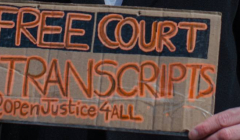
Why Open Justice For All is seeking change for victims
Campaigner Charlotte Schreurs explains why the creative industry is coming together to lobby for change for victims.

James Cannings, Chief Sustainability Officer of MSQ highlights why becoming low carbon companies should be an imperative for every agency, group and supplier across the industry.

For the last six months MSQ have been a carbon negative (or climate positive!) company right across our global operations. We offset a lot more CO2 than we generate through schemes that prevent deforestation, investments into renewable energy, as well as ethical programmes such as low emission cooking stoves in developing nations. In addition to this we have already planted over 65,000 trees and have plans to go a lot further with that.
And whilst I would encourage all businesses, especially those across the service sector, to take this step, it really must just be the very first step on the journey. That’s why we’ve just announced we’re going to halve our carbon footprint per head by 2024, not just relax and pat ourselves on the back for becoming carbon negative.
That was part of what attracted me to the role of Chief Sustainability Officer at MSQ. An ambition to go further. My reasons and motivations for doing what I do are very clear. I can’t put it much better than by using the opening line of David Wallace-Well’s book The Uninhabitable Earth which memorably starts, “It’s worse, much worse than you think.”
Look, I’ve read much on the subject since, and I’m aware that, to some degree, people are weary of being beaten round the head with some of the projections coming from the scientific community. But to borrow some from David’s book:
Becoming low carbon companies should be an imperative for every agency, group and supplier in our industry.
James Cannings
Human brains don’t deal with the concept of a crisis that is 80 years away as well as, for example, being told that a meteor is going to strike the Earth within the next three years - just to be clear, it’s not, at least as far as I’m aware! But if you find it easier to deal with statistics of what is going on around us right now, then consider this. As far as we know, there have been five mass extinction events in Earth's history. Four of them were climate related. And we are currently adding carbon dioxide to the atmosphere at ten times the rate of the last one.
In fact, you are already living through the start of the sixth mass extinction event. The scientific community refers to this as the Holocene extinction and is because around 150 to 200 species of plant, insect, bird and mammal become extinct every 24 hours. This number is estimated to be between 100 and 1,000 times higher than the normal expected rate. And whilst you can argue that these extinctions are not all climate related, they are certainly connected to the destruction of ecosystems, which is driving climate change.
So, over the next few months and years we will certainly post more about our journey to halve our footprint. For any BIMA members out there, you might also consider joining the course that I run to see how you can model and reduce your own carbon footprint, using the tools that we’ve made available through our website.
Initially there is nothing ground-breaking. Important, sure. But nothing unfathomable. That’s a good thing. We need to switch our offices to renewables. And in the post-COVID world, we need to encourage and incentivise our staff to do the same, in turn reducing our ‘homeworker emissions’. We need to focus on strategies for a greener commute and greener in-work travel. And we need to work through all of the suppliers of all of the goods and professional services that we use as an organisation to find greener alternatives, or to work with partners to understand and help with their own reduction and offsetting strategies.
And we need to be open and transparent with all that we do. So, we can help and encourage other organisations too. Because this isn’t a ‘nice little initiative’ from an agency of do-gooders. It’s not a press release that gets a nice feeling of warmth before being forgotten about. And Chief Sustainability Officer isn’t just a nice title to stick on LinkedIn. Becoming low carbon companies should be an imperative for every agency, group and supplier in our industry. It’s time to take the next step.
James co-founded MMT Digital after he graduated in 1999 and has since grown it to be one of the UK's leading technical agencies, with over 160 people and offices in the Midlands, London and Leeds. In 2019 he took the company carbon negative, offsetting far more carbon than they produce. As the co-chair of the BIMA Sustainability Council he now runs a training course for other companies on how to model and reduce their carbon footprints using the tools and processes he developed and that are now available via the website that supports his initiative (netcarbonnegative.co.uk). In 2020 MMT Digital became part of MSQ and, using these techniques, James helped MSQ to became carbon negative across their entire global operations. He was named Chief Sustainability Officer of MSQ in April 2021.
Looks like you need to create a Creativebrief account to perform this action.
Create account Sign inLooks like you need to create a Creativebrief account to perform this action.
Create account Sign in